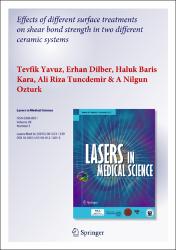| dc.contributor.author | Yavuz, Tevfik | |
| dc.contributor.author | Dilber, Erhan | |
| dc.contributor.author | Kara, Haluk Barış | |
| dc.contributor.author | Tunçdemir, Ali Rıza | |
| dc.contributor.author | Öztürk, Atiye Nilgün | |
| dc.date.accessioned | 10.07.201910:49:13 | |
| dc.date.accessioned | 2019-07-10T20:01:38Z | |
| dc.date.available | 10.07.201910:49:13 | |
| dc.date.available | 2019-07-10T20:01:38Z | |
| dc.date.issued | 2013 | en_US |
| dc.identifier.citation | Yavuz, T., Dilber, E., Kara, H. B., Tunçdemir, A. R. ve Öztürk, A. N. (2013). Effects of different surface treatments on shear bond strength in two different ceramic systems. Lasers In Medical Science, 28(5), 1233-1239. https://dx.doi.org/10.1007/s10103-012-1201-5 | en_US |
| dc.identifier.issn | 0268-8921 | |
| dc.identifier.issn | 1435-604X | |
| dc.identifier.uri | https://dx.doi.org/10.1007/s10103-012-1201-5 | |
| dc.identifier.uri | https://hdl.handle.net/20.500.12511/3378 | |
| dc.description | WOS: 000323742200003 | en_US |
| dc.description | PubMed ID: 22971913 | en_US |
| dc.description.abstract | The purpose of this study was to evaluate the influence of different surface treatments (sandblasting, acid etching, and laser irradiation) on the shear bond strength of lithium disilicate-based core (IPS Empress 2) and feldspathic ceramics (VITA VM 9). One hundred ceramic discs were divided into two groups of 50 discs each for two ceramic systems: IPS Empress 2 (group I) and VITA VM 9 (group II). Each of the two groups was further divided into five surface treatment groups (ten each) as follows: group SB, sandblasting with alumina particles (50 mu m); group HF, 5 % hydrofluoric acid etching; group L, Er:YAG laser irradiation (distance, 1 mm; 500 mJ; 20 Hz; 10 W; manually, noncontact R14 handpiece); group SB-L, sandblasting + Er:YAG laser; and group HF-L, 5 % hydrofluoric acid + Er:YAG laser. Luting cement (Panavia 2.0) was bonded to the ceramic specimens using Teflon tubes. After 24 h of water storage, a shear bond strength test was performed using a universal testing machine at a crosshead speed of 0.5 mm/min. The data were analyzed with a two-way analysis of variance (ANOVA) and Tukey's honestly significant difference tests (alpha = 0.05). The two-way ANOVA indicated that the shear bond strength was significantly affected by the surface treatment methods (p < 0.05), but there was no significant interaction between the ceramic systems. Group SB-L had the highest mean values for each ceramic system. Sandblasting, followed by Er:YAG laser irradiation, enhanced the bond strength, indicating its potential use as an alternative method. The atomic force microscopic evaluation revealed that group SB had the most distinct sharp peaks among the groups. | en_US |
| dc.language.iso | eng | en_US |
| dc.publisher | Springer London Ltd | en_US |
| dc.rights | info:eu-repo/semantics/openAccess | en_US |
| dc.subject | Bond Strength | en_US |
| dc.subject | Luting Cements | en_US |
| dc.subject | Surface Treatment | en_US |
| dc.subject | Ceramic | en_US |
| dc.subject | Er Yag | en_US |
| dc.title | Effects of different surface treatments on shear bond strength in two different ceramic systems | en_US |
| dc.type | article | en_US |
| dc.relation.ispartof | Lasers In Medical Science | en_US |
| dc.department | İstanbul Medipol Üniversitesi, Diş Hekimliği Fakültesi, Protetik Diş Tedavisi Ana Bilim Dalı | en_US |
| dc.authorid | 0000-0002-9292-2074 | en_US |
| dc.identifier.volume | 28 | en_US |
| dc.identifier.issue | 5 | en_US |
| dc.identifier.startpage | 1233 | en_US |
| dc.identifier.endpage | 1239 | en_US |
| dc.relation.publicationcategory | Makale - Uluslararası Hakemli Dergi - Kurum Öğretim Elemanı | en_US |
| dc.identifier.doi | 10.1007/s10103-012-1201-5 | en_US |
| dc.identifier.wosquality | Q2 | en_US |
| dc.identifier.scopusquality | Q1 | en_US |


















